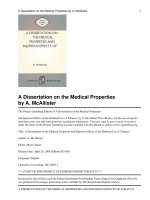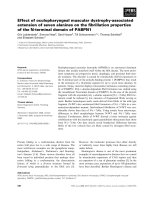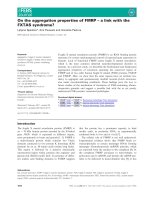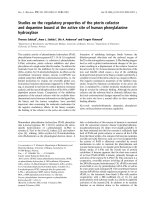Impact of flow-induced disturbances during synthesis on the photophysical properties of naphthalene diimide covalent organic frameworks
Bạn đang xem bản rút gọn của tài liệu. Xem và tải ngay bản đầy đủ của tài liệu tại đây (5.68 MB, 6 trang )
Microporous and Mesoporous Materials 343 (2022) 112122
Contents lists available at ScienceDirect
Microporous and Mesoporous Materials
journal homepage: www.elsevier.com/locate/micromeso
Impact of flow-induced disturbances during synthesis on the photophysical
properties of naphthalene diimide covalent organic frameworks
Hugo Veldhuizen a, Sybrand van der Zwaag a, Monique Ann van der Veen b, *
a
b
Novel Aerospace Materials, Faculty of Aerospace Engineering, Technische Universiteit Delft, 2629 HS, Delft, the Netherlands
Catalysis Engineering, Faculty of Applied Sciences, Technische Universiteit Delft, 2629 HZ, Delft, the Netherlands
A R T I C L E I N F O
A B S T R A C T
Keywords:
Covalent organic frameworks
Stirring synthesis
Taylor-Couette reactor
Naphthalene diimide
Photophysical properties
Flow-induced disturbances were applied during the synthesis of a naphthalene diimide covalent organic
framework (NDI-COF), which resulted in different COF polymer networks. We discovered that a high intensity of
stirring resulted in more aggregated structures on both the micro- and nano-length scale. Subsequently, these
structures absorbed light over longer wavelengths due to a relatively higher contribution of intermolecular in
teractions between the NDI-segments.
1. Introduction
Among the material class of hyper-crosslinked polymers with per
manent porosity, there is the subclass of covalent organic frameworks
(COFs). These polymers are designed to display a degree of crystallinity,
which can range from large single crystals to local crystalline domains of
few repeating units in an overall amorphous network [1]. The porous
structure of a COF depends for a large part on the chemistry and ge
ometry of the building blocks. Moreover, the COF chemistry and poly
mer network dictate the functional properties, such as redox- and
catalytic-activity [2], photovoltaic effect [3] and greenhouse gas cap
ture capacity [4].
Conventional COF synthesis is typically executed in a highly
controlled environment (i.e. glass ampules in an oven), in order to
carefully regulate the experimental conditions (uniform temperature
over long reaction times, inert atmosphere, controlled pressure). In
addition, the reaction mixture is usually static, as it is implicitly
accepted to be more helpful in the formation of regular, crystalline
structures for systems with reversible chemical bonds which would undo
topological imperfections. However, the evidence that optimal func
tional properties are obtained for the best structured networks is weak.
In the field of carbon capture, for example, the amorphous counterparts
of COFs (i.e. porous organic polymers, POPs) reach similar levels of CO2
capacity [5]. As an additional benefit, POPs have a broader library of
linking chemistries to their disposal. Similarly, both COFs and POPs
have shown to be promising redox-active materials in electrochemical
devices (irrespective of their degree of crystallinity) [6,7]. Theoretically,
highly conjugated, crystalline COFs should provide additional electron
transport pathways; boosting the device performance [8]. In practice,
however, both COFs and POPs often still need to be hybridized with
conductive agents for electrode fabrication and their performances
remain comparable.
In this work, we deliberately applied flow-induced disturbances
during the synthesis of a COF to affect the final polymer network. We
distinguished three types of agitation: static, mild, and intense stirring.
The COF chosen for this work is structured by naphthalene diimide
linkages, since the functional properties of the 1D-polymer variants of
these systems have a high dependency on polymer architecture [9,10].
In addition, utilizing poorly-reversible imide-connections in the polymer
backbone fits this research well, since the flow-induced disturbances
should not affect the in-plane crystallinity as much as more reversible
COF systems. The molecular and porous structure of the three NDI-COFs
presented here are characterized with FT-IR, PXRD, N2 sorption, and
SEM, while the focus of the functional properties is on the photophysical
properties.
2. Experimental
2.1. Materials
All reagents presented in this report were commercially available
and used without further purification or treatment. 1,3,5-Tris(4-
* Corresponding author.
E-mail address: (M.A. van der Veen).
/>Received 7 June 2022; Received in revised form 15 July 2022; Accepted 20 July 2022
Available online 5 August 2022
1387-1811/© 2022 The Authors. Published by Elsevier Inc. This is an open access article under the CC BY license ( />
H. Veldhuizen et al.
Microporous and Mesoporous Materials 343 (2022) 112122
2.2. Covalent organic framework synthesis
aminophenyl)benzene (≥93%), 5′ -Phenyl-[1,1’:3′ ,1′′ -terphenyl]-4amine (≥98%), and isoquinoline were purchased from TCI Europe N.V
(Zwijndrecht, Belgium), 1,4,5,8-naphthalenetetracarboxylic dianhy
dride (≥95%) and ortho-dichlorobenzene from abcr GmbH (Karlsruhe,
Germany) and N-methyl-2-pyrrolidone from Acros Organics B.V.B.A
(Geel, Belgium).
Fig. 1 shows a schematic overview of the COF chemistry and
different synthesis methods employed in this research. All syntheses
were performed in borosilicate glass flat-bottom 100 mL cylindrical
reactors, using the monomers 1,3,5-tris(4-aminophenyl)benzene
(TAPB),
and
1,4,5,8-naphthalenetetracarboxylic
dianhydride
(NTCDA). COFs named ‘static’ were not agitated during synthesis, while
‘stir bar’ COFs were continuously stirred with a conventional stir bar.
Lastly, intense stirring was applied by utilizing a cylindrical mechanical
stirrer in the reactor, resembling a Taylor-Couette reactor (TCR) [11].
Considering the rotational speed and dimensions of the reactor and
stirrer, the continuous and homogeneous shear rate for the TCR method
is estimated at 250 s− 1. On the other hand, the stir bar method imposes a
highly heterogeneous shear rate; ranging from γ˙ min = 4.5 s− 1 to a very
local maximum at the stir bar tip of γ˙ max = 190 s− 1 (Fig. S2). The detailed
synthesis protocols of static, stir bar and TCR COFs are documented in
the Supporting Information, as well as the details on characterization
techniques. The data concerning the characterization of the materials
described in this work can be accessed and used by others for further
studies at 4TU.ResearchData [30].
3. Results and discussion
Completion of the polycondensation reactions of the stir bar-, and
TCR-COFs was confirmed by FT-IR (Fig. S4). All three different syn
theses yielded polyimide polymers, which was apparent from the
– O (1715
appearance of symmetric (1674 cm− 1) and asymmetric C–
cm− 1) imide peaks and C–N imide peaks (1339 cm− 1), combined with
the disappearance of characteristic functional group vibrations of the
originating monomers. No significant molecular differences between the
differently agitated syntheses were observed. The thermal stabilities of
the three COFs are similar as well (Fig. S5), with the main decomposition
at a maximum around the temperature range of 640–660 ◦ C. In addition,
a minor weight loss (5–10 wt %) is present in the region of 300–500 ◦ C
for all COFs. The origin of this weight loss is yet unclear: it could be
trapped solvent species, unreacted monomer, and/or water release due
to cyclization reactions of unreacted poly(amic acid).
PXRD measurements revealed that all COFs display similar crystal
line order, being only on a short, local length scale (Fig. S6), as is also the
case for previously reported COFs with the same polymer chemistry [6,
12]. The static-, stir bar-, and TCR-COFs all show (100) and (200) re
flections (where the former at 2.8◦ corresponds to the expected hexag
onal size of 3.1 nm; previously investigated by our group through
molecular modelling) [6]. Agitation during synthesis did influence the
porosity of the COFs significantly, which we investigated by measuring
nitrogen sorption isotherms (Fig. 2A). While the stir bar-COF shows very
similar isotherm curves to the static-COF, the TCR-COF’s porosity
decreased notably: in particular the isotherm knee around 0.25 P/P0
became less pronounced and the increase in N2 uptake between 0.05 and
0.25 P/P0 diminished. These observations indicate a reduction in small
mesopore volume and a broader pore size distribution (PSD) of
TCR-COFs. The PSDs were calculated based on the adsorption branches
of the COFs (Fig. 2B), using a quenched solid density functional (QSDFT)
model that is based on carbon materials with slit and cylindrical pore
geometries [13]. The fitting curves of the PSD calculations are provided
in the Supplementary Fig. S7. Finally, the overall Gurvich pore volume
based on the N2 uptake at 0.9 P/P0 are 0.49, 0.50 and 0.37 cm3 g− 1 for
the static-, stir bar- and TCR-COFs respectively.
SEM micrographs of the COFs prepared by the three synthesis
methods are shown in Fig. 3. First, in the zoomed-out micrographs
(Fig. 3 left), the large agglomerates (ranging from 20 to 200 μm) of the
static-COFs stand in stark contrast to the more uniform and smaller
particles of the stir bar- and TCR-COFs (sizes between 10 and 20 μm).
Secondly, on a smaller length scale (Fig. 3 right) a clear distinction in
morphology is observed when comparing non-agitated to agitated COFs.
Fig. 1. Schematic overview of COF formation by polycondensation of TAPB
and NDA, and the three different synthesis methods: (I) static: no agitation, (II)
continuous stirring with a stir bar, and (III) high-intensity stirring in a TaylorCouette reactor (TCR).
2
H. Veldhuizen et al.
Microporous and Mesoporous Materials 343 (2022) 112122
Fig. 2. A) Nitrogen gas sorption isotherms of static-, stir bar- and TCR-COFs. B) Pore size distributions of static-, stir bar- and TCR-COFs based on the adsorption
branch of the nitrogen isotherms and a QSDFT (slit-cylindrical pore geometry) carbon model.
3
H. Veldhuizen et al.
Microporous and Mesoporous Materials 343 (2022) 112122
Fig. 3. SEM images of static-, stir bar-, and TCR-COFs. The scale bars are the same for each column: left 100 μm, right 1 μm.
The ‘open’, dendritic-like structures of static-COFs are distinguished
from the more collapsed, aggregated-spherical structure of the stir barand TCR-COFs.
Evidently, the shear rates applied during the synthesis of NDI-COFs
have a significant effect on the final polymer network, without
affecting the polymer chemistry or in-plane crystallinity. This observa
tion is quite interesting, since the majority of published COF syntheses
(where optimization is directed towards the highest degree of crystal
linity) invariably involve only static reaction mixtures under sol
vothermal conditions and only effects of polymer chemistry,
temperature and time on morphology are captured.
Regarding the porous structures of the three polymer powders, the
mesopore volume derived from the crystalline pores of 3.1 nm as
observed by PXRD, likely originates from local areas of stacked hexag
onal units within the polymer. The clear maximum in PSDs of static- and
stir bar-COFs suggest a relatively uniform stacking mode within these
local areas of stacked hexagonal units. In contrast, the stacking mode is
more random with larger offsets for TCR-COFs, since this would yield a
reduction in mesopore volume and a broader maximum [14]. In addi
tion, the mesopore volume could also be reduced through pore blocking
within the polymer aggregates or interpenetration of neighbouring local
stacks. In both cases, this decrease in mesopore volume of TCR-COFs
suggests a high degree of aggregation on the nanoscopic scale.
Furthermore, SEM images at low magnification show that the static COF
has a much larger agglomerate size than the other two powders. This
was to be expected, since sufficient stirring intensities break up loosely
bound particles while the agglomerates grow [15]. However, when
examined at higher magnification the stir bar- and TCR-COFs display
larger single particle sizes, while appearing increasingly more aggre
gated. We expect that the effects of stirring in this regard are two-fold:
(1) homogeneously distributed monomers in their stochiometric ratios
causing a higher molecular weight and subsequently larger, more uni
form particles [16], and (2) additional flow forces acting on the forming
particles causing the polymer network to be formed in a more inward
facing, collapsed manner [17]. According to these results, we have
employed a facile approach towards morphology control in NDI-COF
systems.
Structural control on the nanoscale in NDI-based systems may play a
large role in controlling their photophysical properties. This phenome
non has been observed in mesoporous silicas containing chemically
similar perylene diimide segments [18]. Also in the case of polyimine
COFs, Deng and coworkers have recently shown how careful regulation
of interlayer packing through COF chemistry can enhance the optical
properties [19]. Therefore, we investigated how the observed structural
changes in the COFs presented here, affected these properties. We
observed stark differences in their UV–Vis spectra (Fig. 4A). Each COF
has a different λmax, being 393 nm for static, 417 nm for stir bar, and 446
nm for TCR COFs, where red-shifts of these maxima typically indicate
longer conjugation lengths. Furthermore, the absorbance intensity of the
secondary shoulder peak (in the range of 490–510 nm) is much more a
distinct peak in the TCR-COFs.
In order to attribute the observed changes in spectral features to their
chemical and structural origins, we synthesized a model compound that
represents an isolated repeating unit of the COF framework (Fig. 4B).
The 0–2, 0–1, and 0-0 absorption bands of this molecule at λmax of 345,
361, and 380 nm respectively are clearly visible in the liquid state and
4
H. Veldhuizen et al.
Microporous and Mesoporous Materials 343 (2022) 112122
are in line with characteristic π-π* transitions of other NDI-based ma
terials [20]. The UV spectrum of the same model compound in the solid
state, however, shows light absorption over a broad range of wave
lengths with distinct spectral features. Next to the NDI π-π* transition at
380 nm, we observed two shoulder peaks between 430 - 450 nm and
496–510 nm. These differences in UV absorbance behaviour from the
solvated state in NDI-based systems has extensively been studied and are
often attributed to self-organization [20]. The presence of two distinct
shoulders at longer wavelengths suggests multiple different intermo
lecular stacking modes [21]. In NDI-based small molecule systems, this
has been further explored by combining these molecules with
electron-rich aromatic donors (e.g. pyrene or derivatives thereof). Here,
charge transfer (CT) complexes, that are a result of electrons in the
HOMO of the donor promoted to the LUMO of the NDI-unit, are
observed through the appearance of a characteristic broad absorption
band centred around 500–550 nm [22,23]. It is possible that the phenyl
rings of the triphenylbenzene segments acted as electron donors in the
self-organization of the model compound [24], as well as in local areas
within the polymer networks of the COFs. The position and intensity of
this CT band relies on multiple factors, such as the orbital overlap and
solvent effects (chemical environment). Lastly, photoluminescence (PL)
measurements were conducted to investigate the effect of differently
packed polymer networks on excited-state properties. Excitation at 450
nm triggered the same emission behaviour for all COFs and the model
compound (Fig. 4C), implying that this is caused by the main absorption
bands of NDI segments that are present in all materials. On the other
hand, excitation at 560 nm red-shifted the emission spectra of the COFs
and model compound in a similar trend to the absorption spectra. This
PL behaviour has been observed in NDI-based polymers and is indicative
of a large content of inter-polymer NDI aggregates present in TCR-COFs,
which would yield red-shifted aggregation-induced emission [9,25].
The distinct nanostructures of the COFs investigated here lead to
distinctly different photophysical properties. The differences in ab
sorption spectra between the static- and stir bar COFs are relatively
small compared to their differences with the TCR-COF. These trends are
similar to the trends observed when comparing the PSDs and mesopore
volume. Thus, we were able to correlate the TCR-synthesis method to a
different nanostructure (through observation of a lower mesopore vol
ume), and subsequently to the COF’s light absorbance and aggregationinduced emission. While engineering the optical properties in COFs
typically relies on chemically altering the building blocks [25–27], we
have shown that changing the processing-side of the synthesis may lead
to similar changes. In a similar vein, we anticipate that mechanochem
ical concepts such as ball milling synthesis (that have been applied to
other porous materials) [28], are promising for alternative COF prepa
ration routes with enhanced properties as well.
4. Conclusion
In summary, COFs prepared via a static method display an out
stretched, open polymer network, with a relatively lower contribution of
intermolecular NDI-based interactions. On the other hand, a high in
tensity of stirring during synthesis yields a COF polymer network that is
more aggregated in micro- and nano-length scales, which causes an
overall higher contribution of intermolecular NDI-based interactions.
We anticipate that utilisation of these synthesis strategies for NDI-COFs
will affect their electrochemical device performance, because of its
reliance on charge transport between aggregated NDI-based polymer
chains [29]. While the effects have been shown for one COF system only,
we expect that the route is more generic and can be applied successfully
to other COF and COF related systems.
Fig. 4. A) Kubelka-Munk absorbance spectra of static-COF, stir bar-COF and
TCR-COF measured by diffuse reflectance spectroscopy. B) UV absorbance
spectrum of the model compound: dissolved in toluene (black line) and in the
solid state (blue line, K-M absorbance). The step-change around 687 nm is an
artefact of the measurement. C) Photoluminescence spectra of static-COF, stir
bar-COF and TCR-COFs and the model compound, at excitation wavelengths of
450 (left) and 560 (right) nm. (For interpretation of the references to colour in
this figure legend, the reader is referred to the Web version of this article.)
CRediT authorship contribution statement
Hugo Veldhuizen: Writing – original draft, Visualization, Valida
tion, Methodology, Investigation, Formal analysis, Data curation,
5
H. Veldhuizen et al.
Microporous and Mesoporous Materials 343 (2022) 112122
Conceptualization. Sybrand van der Zwaag: Writing – review & edit
ing, Validation, Supervision, Methodology, Formal analysis, Conceptu
alization. Monique van der Veen: Writing – review & editing,
Validation, Supervision, Formal analysis, Conceptualization.
[8] S. Patwardhan, A.A. Kocherzhenko, F.C. Grozema, L.D.A. Siebbeles, J. Phys. Chem.
C 115 (2011) 11768–11772, />[9] Y. Wu, S. Schneider, C. Walter, A.H. Chowdhury, B. Bahrami, H.C. Wu, Q. Qiao, M.
F. Toney, Z. Bao, J. Am. Chem. Soc. 142 (2020) 392–406, />10.1021/jacs.9b10935.
[10] D. Fazzi, M. Caironi, Phys. Chem. Chem. Phys. 17 (2015) 8573–8590, https://doi.
org/10.1039/C5CP00523J.
[11] M. Schrimpf, J. Esteban, H. Warmeling, T. Fă
arber, A. Behr, A.J. Vorholt, AIChE J.
67 (2021) 1–24, />[12] Q. Fang, Z. Zhuang, S. Gu, R.B. Kaspar, J. Zheng, J. Wang, S. Qiu, Y. Yan, Nat.
Commun. 5 (2014) 4503, />[13] A.V. Neimark, Y. Lin, P.I. Ravikovitch, M. Thommes, Carbon 47 (2009)
1617–1628, />[14] C. Kessler, R. Schuldt, S. Emmerling, B.V. Lotsch, J. Kă
astner, J. Gross, N. Hansen,
Microporous Mesoporous Mater. 336 (2022), 11796, />micromeso.2022.111796.
[15] S.H. Kang, S.G. Lee, W.M. Jung, M.C. Kim, W.S. Kim, C.K. Choi, R.S. Feigelson,
J. Cryst. Growth 254 (2003) 196–205, />01152-7.
[16] G. Gonz´
alez, E. Colmenar, G. Diaconu, F. Alarcia, M. Manea, M. Paulis, M.
J. Barandiaran, J.R. Leiza, J.C. de la Cal, J.M. Asua, Macromol. React. Eng. 3
(2009) 233–240, />[17] L. Gu´erin, C. Coufort-Saudejaud, A. Lin´e, C. Frances, J. Colloid Interface Sci. 491
(2017) 167–178, />[18] F.J. Trindade, G.J.T. Fernandes, A.S. Araújo, V.J. Fernandes Jr., B.P.G. Silva, R.
Y. Nagayasu, M.J. Politi, F.L. Castro, S. Brochsztain, Microporous Mesoporous
Mater. 113 (2008) 463–471, />[19] L. Zhang, Y. Zhou, M. Jia, Y. He, W. Hu, Q. Liu, J. Li, X. Xu, C. Wang, A. Carlsson,
S. Lazar, A. Meingast, Y. Ma, J. Xu, W. Wen, Z. Liu, J. Cheng, H. Deng, Matter 2
(2020) 1049–1063, />[20] S. Maniam, H.F. Higginbotham, T.D.M. Bell, S.J. Langford, Chem. Eur J. 25 (2019)
7044–7057, />[21] M. Pandeeswar, H. Khare, S. Ramakumar, T. Govindaraju, RSC Adv. 4 (2014)
20154–20163, />[22] P. Li, J.M. Maier, J. Hwang, M.D. Smith, J.A. Krause, B.T. Mullis, S.M.S. Strickland,
K.D. Shimizu, Chem. Commun. 51 (2015) 14809–14812, />C5CC06140G.
[23] M.D. Gujrati, N.S.S. Kumar, A.S. Brown, B. Captain, J.N. Wilson, Langmuir 27
(2011) 6554–6558, />[24] N.A. Kukhta, D. Volyniuk, J.V. Grazulevicius, G. Sini, J. Mater. Chem. C 6 (2018)
1679–1692, />[25a] R. Steyrleuthner, M. Schubert, I. Howard, B. Klaumünzer, K. Schilling, Z. Chen,
P. Saalfrank, F. Laquai, A. Facchetti, D. Neher, J. Am. Chem. Soc. 134 (2012)
18303–18317, />[25b] X. Li, Q. Gao, J. Aneesh, H. Sen Xu, Z. Chen, W. Tang, C. Liu, X. Shi, K.V. Adarsh,
Y. Lu, K.P. Loh, Chem. Mater. 30 (2018) 5743–5749, />acs.chemmater.8b02560.
[26] Y. Zhao, X. Liu, Y. Li, M. Xia, T. Xia, H. Sun, Z. Sui, X. Hu, Q. Chen, Microporous
Mesoporous Mater. 319 (2021), 111046, />micromeso.2021.111046.
[27] L. Zhang, L. Yi, Z.-J. Sun, H. Deng, Aggregate 2 (2021), e24, />10.1002/agt2.24.
[28] B. Szczę´sniak, S. Borysiuk, J. Choma, M. Jaroniec, Mater. Horiz. 7 (2020)
1457–1473, />[29] S. Wang, S. Fabiano, S. Himmelberger, S. Puzinas, X. Crispin, A. Salleo,
M. Berggren, Proc. Natl. Acad. Sci. U. S. A 112 (2015) 10599–10604, https://doi.
org/10.1073/pnas.1501381112.
[30] Data related to the paper is stored at the 4TU.Research Data repository. https://do
i.org/10.4121/20343237.
Declaration of competing interest
The authors declare that they have no known competing financial
interests or personal relationships that could have appeared to influence
the work reported in this paper.
Data availability
The data concerning the characterization of the materials described
in this work can be accessed and used by others for further studies at
4TU.ResearchData : />Acknowledgments
The authors thank Dr. Lorenzo Botto and Dr. Hugo Perrin for valu
able discussions regarding reactor design, experimental parameters, and
shear rate estimations. The authors also thank Ing. Bahiya Ibrahim for
her assistance during the photoluminescence measurements.
Appendix A. Supplementary data
Supplementary data to this article can be found online at https://doi.
org/10.1016/j.micromeso.2022.112122.
References
[1] T. Ma, E.A. Kapustin, S.X. Yin, L. Liang, Z. Zhou, J. Niu, L.-H. Li, Y. Wang, J. Su,
J. Li, X. Wang, W.D. Wang, W. Wang, J. Sun, O.M. Yaghi, Science 361 (2018)
48–52, />[2] K. Zhang, K.O. Kirlikovali, R.S. Varma, Z. Jin, H.W. Jang, O.K. Farha,
M. Shokouhimehr, ACS Appl. Mater. Interfaces 12 (2020) 27821–27852, https://
doi.org/10.1021/acsami.0c06267.
[3] M. Calik, F. Auras, L.M. Salonen, K. Bader, I. Grill, M. Handloser, D.D. Medina,
M. Dogru, F. Lă
obermann, D. Trauner, A. Hartschuh, T. Bein, J. Am. Chem. Soc. 136
(2014) 17802–17807, />[4] H. Furukawa, O.M. Yaghi, J. Am. Chem. Soc. 131 (2009) 8875–8883, https://doi.
org/10.1021/ja9015765.
[5] W. Wang, M. Zhou, D. Yuan, J. Mater. Chem. 5 (2017) 1334–1347, />10.1039/C6TA09234A.
[6] R. van der Jagt, A. Vasileiadis, H. Veldhuizen, P. Shao, X. Feng, S. Ganapathy, N.
C. Habisreutinger, M.A. van der Veen, C. Wang, M. Wagemaker, S. van der Zwaag,
A. Nagai, Chem. Mater. 33 (2021) 818–833, />chemmater.0c03218.
[7] N. Fernando, H. Veldhuizen, A. Nagai, S. Van der Zwaag, A. Abdelkader, Materials
15 (2022) 4, />
6









